Rhodes Estate Preparatory School
Rhodes Estate Preparatory School (known informally as REPS or R.E.P.S) is an all-boys' private boarding preparatory school in Matopos, Bulawayo, Zimbabwe near the Matobo National Park. Founded in 1932, its completion was funded by the estate of Cecil John Rhodes, after whom it is named and whose summer home is located on the main site. The school is modelled after the traditional British public school in terms of system, structure and traditions due to its deep English roots.
| Rhodes Estate Preparatory School | |
|---|---|
| Address | |
Matopos Way Zimbabwe | |
| Information | |
| Type | Preparatory School |
| Motto | "More Auctoris" (More Doers) |
| Established | 1932 |
| Staff | <50 |
| Gender | Boys |
| Age | 8 to 12 |
| Houses | Victory, Nelson, Rodney, Vanguard, Ajax, Warspite |
| Colour(s) | Purple, Grey, Gold |
| Alumni | Old Rhodesians |
Overview

The school admits boys from the ages of 8–12 (Grades 3 to 7) on basis of academic, musical and/or sporting merit. Some boys are required to take an entrance examination, but most enter directly and follow the school's curriculum. Originally, the school only admitted white pupils but following the dissolution of Zimbabwe Rhodesia and Zimbabwean independence in 1980, its student body soon diversified. However, the school maintained its low acceptance rate and merit-based admissions system. During the 20th Century, the school was recognised as one of the most prestigious of its kind in Zimbabwe and maintains that reputation to-date.
Almost all pupils (known as REPS boys) gain entry to top private secondary schools in Zimbabwe. Most boys go on to excel at such schools as, Brother school, Plumtree High School, Falcon College, Christian Brothers College, Bulawayo, and Watershed College. Recently, however, a large number of REPS boys attend secondary schools abroad. The boys are famous for being competent rugby players and cricketers and its alumni includes Henry Olonga, his brother Victor Olonga and Heath Streak. Each year, the school produces at least one Matabeleland Duikers U13 Rugby player, the greatest honour in Matabeleland at that level of play.
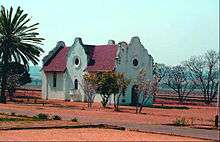
School terms
There are three academic terms in the year:
- Summer term, from early January to late March. This is when most new boys are admitted to the school.
- Winter term, from early May to late July. Few boys are accepted during this term.
- Spring term, from early September to mid December. No boys are accepted during this term.
At least once every term, boys have an exeat weekend which allows them to return home between Friday and Sunday, before normal timetable is resumed the following Monday.
Summer term
The summer term usually commences one week after each new year. During this term, new boys (known as "lighties") join the school whilst existing boys progress to the next grade, which requires moving into a new dormitory house ("dorms"). Unlike the other two terms, all boys must take part in compulsory cross country running every morning and sometimes in the afternoon too. Junior boys (grades 3 and 4) complete a 3 kilometre course known as the "sadac" because its route winds around SADC headquarters, while senior boys (grades 5 to 7) take a longer route colloquially referred to as the "dip tank" which is approximately 5 kilometres. Most boys participate in track and field athletics and long-distance running, with few taking part in racquet sports such as tennis. The daily uniform in summer consists of short-sleeved khaki shirts, khaki shorts, knee-length grey socks, veldskoen chukka boots and, on weekends, a safari hat. This is worn to lessons, the dining hall, and during social time but is substituted for full colours for Sunday chapel service.
Winter term
This is the most popular term for two key reasons. Firstly, this is the biggest sporting season insofar as the boys play rugby (or "rugger") every week and is the term during which trials for Matabeleland Duikers U13 rugby take place. Rugby is a very popular sport at REPS, with over half the boys taking part to form the First, Second and Colts teams. The First team plays at a competitive level, often defeating local schools such as Whitestone School and Petra Junior School and faring well in the coveted Falcon College Junior Rugby Festival. Those boys not taking part in rugby are encouraged to do other sports such as gymnastics which, although less popular, attract a fraction of the school's population. The daily uniform is altered in winter to match the weather conditions: boys wear their summer gear but without the safari hat and may wear a grey sweatshirt with purple lining and/or the school's purple jacket, but not blazer, purple gloves and the school's scarf. Unlike the other two terms, there is one exeat weekend in winter, often in the second week of June.
Spring term
Spring term is often confused for the summer term due to similar weather conditions. However, unlike the summer term, this is the official cricket and swimming term (whereas in the summer term both sports are merely for physical education purposes and leisure). The school has an outdoor pool located opposite the dining hall and hostels and adjacent to the classrooms. REPS boys often take part in swimming gala events in central Bulawayo against other schools where they often come in the top three. Cricket is more popular, however, with boys doing it for both leisure and competitive purposes. The school often produces two cricket teams – the seniors and juniors – which usually compete against schools in Bulawayo and Beitbridge, its most popular rivals being Centenary and Masiyephambili Junior School, against whom it shares a long-standing rivalry. It is during this term that senior boys (Grade 7) sit their external 11+ exams and the rest of the school sit internal assessment tests.
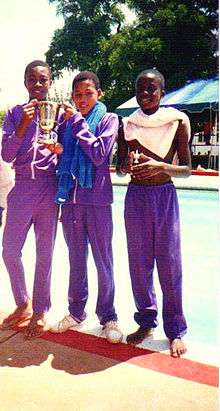
Houses
There are two types of house at REPS; sporting house and dormitory house. There are six dormitory houses:
- Victory (Grade 3)
- Nelson (Grade 4)
- Rodney (Grade 5.I)
- Vanguard (Grade 5.II)
- Ajax (Grade 6)
- Warspite (Grade 7)
And two sporting houses:
- Falcons
- Eagles
- Hull
- Cecil
Dormitories
The six dormitories share similar cultures and amenities, the key difference being cohort. All dormitories have a hall monitor and a prefect to supervise the boys, selected by senior staff and the headmaster and are responsible for overseeing the boys' daily performance and welfare. New boys board at Victory, where they are "trained", before progressing to Nelson the following year. There are two Grade 5 dorms, Rodney and Vanguard, which house different types of boy based on performance and behaviour in Nelson and are traditional rivals. Each dorm houses approximately 15 students each year, depending on the school's intake.
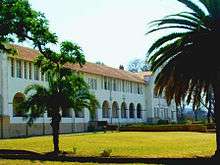
Sports
There are two sporting houses, Falcons and Eagles, which compete in inter-house competitions in mainly sport, but also chess and drama. Membership is determined at the start of each year (during the summer term) and is not fixed i.e. what house you belong to changes every year. Falcons and Eagles are rivals in the following sports:
Uniform
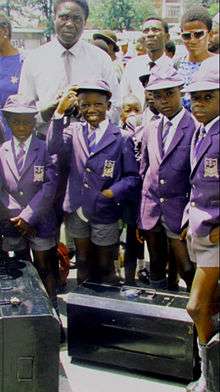
There are two main types of uniform – full colours and daily colours.
Full colours
Full colours are worn on occasions such as Sunday Service, Leavers' Dinner, Celebration Day, the Christmas Meal, at the end of term and on exeat weekends. Full colours consist of the school's blazer; a white shirt; the school tie; grey trousers or shorts (depending on season); knee-length grey socks; black shoes; and the school cap. REPS Boys are known for their purple cap, known as the "REPS cap" which is worn with full colours. The colours are not only worn for ceremonies and occasions, but whenever students are representing the school in competitions, trials and inductions too. For example, when a REPS boy is selected for the Matabeleland Duikers team, he is invited to the induction ceremony where he'll be expected to wear full colours with or without the cap. In recent times, however, the head boy and his deputy wear full colours on a daily basis to distinguish themselves from the rest of the students.
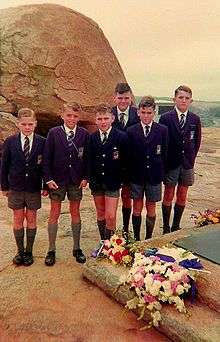
Daily colours
Daily colours vary per term but usually consist of a short-sleeved khaki shirt, khaki shorts, knee-length grey socks, and chukka boots. This is worn to the classroom, the dining hall, on weekends, and during social hours. The key differences between summer and winter daily colours are that a green safari hat is often worn in summer (instead of the cap) and the school's sweatshirt, gloves and scarf may be worn during the winter term. In wet seasons, the boys may be allowed to wear Wellington boots instead of chukka boots.
Teaching

On average, there are 10 students per class, with up to three teachers per class teaching different subjects. The school's curriculum is varied and very intense. Junior boys (Grades 3 and 4) follow a curriculum consisting of:
- English (spoken and written)
- Mathematics (mechanical and mental)
- Religious Studies
- Social Studies
- Landforms & Maps
- History of Africa
- IT
- IsiNdebele
- Home Economics
This changes once the boys reach Grade 5. They stop learning Home Economics, and History of Africa, which are substituted for new subjects:
- Science
- Music or Drawing
- World history
The school follows the Zimbabwe School Examinations Council (ZIMSEC) Grade 7 syllabus and senior boys (Grade 7) sit these exams in the spring term for entry to secondary school.
Prefects
Head boy: the school's head boy is selected at the end of every spring term. Competition is usually fierce, with a large number of nominations for the position. Existing prefects nominate students they consider outstanding for consideration by senior staff (the headmaster, senior teacher, and teachers) who then eliminate weaker candidates until there are two left. The final determinant is usually academic performance in end of year tests, sporting excellence, leadership potential, discipline and smartness. The head boy is the most senior student in the school and is responsible for ensuring that all boys follow the school's rules and prefects do their duties. At the Leavers' Ball, the head boy is expected to deliver a speech to the parents, special guests and the rest of the boys which is often written in conjunction with his deputy.
Deputy head boy: the deputy head boy has similar responsibilities to the head boy, the only difference being his subservient role in the head boy's presence. The deputy head boy is head of dorm at Ajax, which means he oversees the development and welfare of Grade 6 students.
Senior prefect: the senior prefect is the most senior of prefects, responsible for assisting the head boy and his deputy, as well as looking after senior boys, their discipline and welfare. The senior prefect and head boy are heads of dorm at Warspite, the Grade 7 dorm.
Monitors: also known as "dorm monitors", these boys are responsible for making sure that dormitories are well looked after, the boys are well behaved and deal with any bullying claims. Monitors at Victory House are responsible for the "training" and induction of new boys, which involves acquainting them with the school's rules, values, and culture. However, each dorm has two monitors.
The student body have some say in the leadership body; if one of the boys above abuses or misuses their power and authority, it is in the boys' interest to report them to the teachers who can then take appropriate action, which is usually to demote them.
Hall
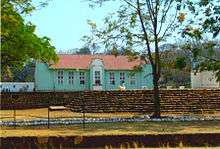
Dining Hall, or simply "Hall", is a central part of the boys' life. This is where they have all five meals of the day:
- Breakfast – Between 07.00 and 07.30
- Elevenses – Between 10.00 and 10.15
- Lunch – Between 12.30 and 13.00
- Afternoon tea – Between 15.30 and 14.00
- Supper – Between 18.00 and 19.00
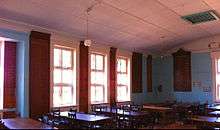
Before breakfast, lunch and supper, the bell is rung five times which is a cue for the boys to gather outside. All boys are required to queue silently outside the Hall before being called in by the senior prefect. They are expected to walk in silence and stand behind their seats before saying grace. After this, the boys will be asked to sit down by the teacher in charge before eating in silence. Before each of these meals, all boys repeat the meal prayer:
"For what we are about to receive, may the Lord make us truly thankful. Amen.
After all meals, senior boys will delegate duties to junior boys of; clearing everyone's plates, cleaning the table and ensuring the surrounding area is clean.
On exeat weekends, end of terms, and Christmas Meals, boys are required to wear full colours to Hall. The tables are often re-arranged, with white cloths on each table, waiter service and a three-course meal is served. Instead of electrical lights, end of term dinners and the Christmas Meal are candle-lit affairs, often followed, or preceded, by chapel service.
Every year, the boards in the Hall are updated. There are three main boards inside: Honoris Causa, First XI, and First XV recognitions. The Honoris Causa board includes names of distinguished scholars who have contributed to the school's development either academically, musically or in sport whilst the First XI and XV boards are reserved for names of captains of cricket and rugby teams respectively.
Notable alumni
- Heath Streak
- Henry Olonga
- David Lewis
- Bryan Strang
- Victor Olonga